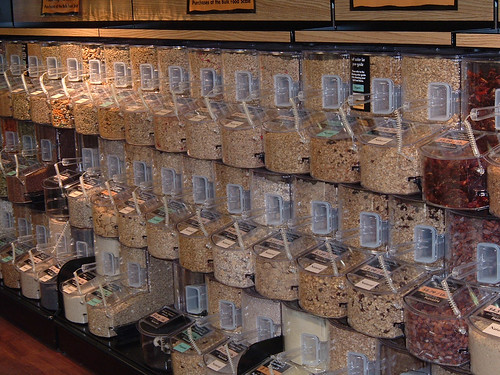 Become aware of what staples you use regularly in your cooking, and stop buying small packages and bottles of them when larger sizes are available. For instance, I'm always using a lot of soy sauce in marinades and meat dishes, so it makes no sense to buy a small 12 or 16oz bottle when I can buy 2 quarts at a much better price! Does your family go through a lot of mayo? Avoid the fancy little squeeze-bottles and go for a big jar, if you'll go through it all before its expiration date. I also buy staples such as flour, rice and dried beans in large quantities when I can, because they will last a long time and not go wasted in this house.
Become aware of what staples you use regularly in your cooking, and stop buying small packages and bottles of them when larger sizes are available. For instance, I'm always using a lot of soy sauce in marinades and meat dishes, so it makes no sense to buy a small 12 or 16oz bottle when I can buy 2 quarts at a much better price! Does your family go through a lot of mayo? Avoid the fancy little squeeze-bottles and go for a big jar, if you'll go through it all before its expiration date. I also buy staples such as flour, rice and dried beans in large quantities when I can, because they will last a long time and not go wasted in this house.
The trick however is to make sure your bulk food purchases are stored well - especially grains, nuts, flour and pasta which can get stale or even infested with bugs if not in good containers. Invest in some attractive, tightly sealing glass jars and canisters - plastic food storage tubs won't do the job! If you buy meat in bulk or so-called family packs, divide them up as soon as you get home, wrapping individual servings well in freezer bags before freezing.
What about Wholesale Clubs? Are they good money savers for buying in bulk?
Costco, Sam's Club, BJ's...some people swear by them, but I don't, at least not for grocery shopping. If you have a very large family to feed, perhaps you can do well at these wholesale clubs. But my problem is that fresh produce can generally only be bought in large quantities at a time in these stores - so large that my partner and I can never finish them all before they spoil. The meat in my opinion is not of remarkable quality, and much of the food products are prepackaged, frozen, boxed, canned, etc....not the kind of fresh and healthy eating we enjoy. So before you shell out the money to join one of these clubs, take a close look at the products they have available and whether you'd really be saving any money by joining - or just buying a lot of food you won't use and don't need.
Image credit


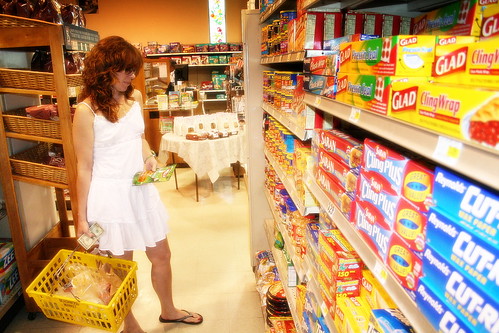 There is a price you must be willing to pay if you want to save money on your food shopping and eat healthier: your time. You have to be willing to plan your meals in advance more carefully; be ready to learn to slow-cook different vegetables and cuts of meat; to take stock of your food supplies, and perhaps buy certain new appliances or kitchen utensils that will save you money in the long run.
There is a price you must be willing to pay if you want to save money on your food shopping and eat healthier: your time. You have to be willing to plan your meals in advance more carefully; be ready to learn to slow-cook different vegetables and cuts of meat; to take stock of your food supplies, and perhaps buy certain new appliances or kitchen utensils that will save you money in the long run. A shopping list will help you stay focused when you go to the store, and make sure that you don't forget something important that could keep you from making that meal you'd been planning for dinner! Don't end up getting stuck ordering take-out because you forgot butter or vegetable oil to cook with, or the potatoes you wanted to serve with your roast.
A shopping list will help you stay focused when you go to the store, and make sure that you don't forget something important that could keep you from making that meal you'd been planning for dinner! Don't end up getting stuck ordering take-out because you forgot butter or vegetable oil to cook with, or the potatoes you wanted to serve with your roast.

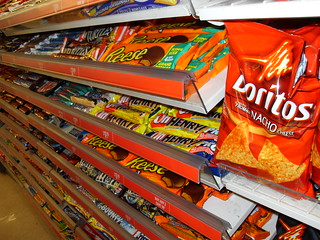 Has this ever happened to you? You're running errands, dashing out to the market, and absolutely famished before you even step foot in the grocery store. You walk inside and everything looks so good, you just can't resist. Sticking to what's on your shopping list becomes impossible. The aroma of a fresh roasted chicken makes you grab one to go, or some doughnuts or snack chips for the car. Suddenly your planned $50 shopping trip has turned into a $100 binge of food you don't even need, but it sure looked or smelled good at the time!
Has this ever happened to you? You're running errands, dashing out to the market, and absolutely famished before you even step foot in the grocery store. You walk inside and everything looks so good, you just can't resist. Sticking to what's on your shopping list becomes impossible. The aroma of a fresh roasted chicken makes you grab one to go, or some doughnuts or snack chips for the car. Suddenly your planned $50 shopping trip has turned into a $100 binge of food you don't even need, but it sure looked or smelled good at the time!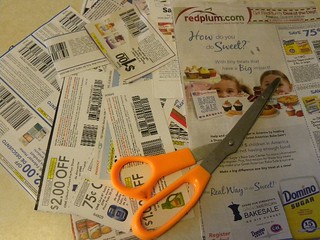 Of course, most people know about clipping coupons and checking advertised weekly sales at the supermarket to look for good deals. The problem I have with solely relying on this method to save money is that coupons are often for processed, packaged food products that aren't necessarily your healthiest options - and you're still paying a premium over making your own (see section below on making your own snack foods.) Of course, that's not to say one can't find useful coupons at times for kitchen staples and household goods, but don't buy things you don't really need or are overpriced to begin with just because they're "on sale".
Of course, most people know about clipping coupons and checking advertised weekly sales at the supermarket to look for good deals. The problem I have with solely relying on this method to save money is that coupons are often for processed, packaged food products that aren't necessarily your healthiest options - and you're still paying a premium over making your own (see section below on making your own snack foods.) Of course, that's not to say one can't find useful coupons at times for kitchen staples and household goods, but don't buy things you don't really need or are overpriced to begin with just because they're "on sale".

 Become aware of what staples you use regularly in your cooking, and stop buying small packages and bottles of them when larger sizes are available. For instance, I'm always using a lot of soy sauce in marinades and meat dishes, so it makes no sense to buy a small 12 or 16oz bottle when I can buy 2 quarts at a much better price! Does your family go through a lot of mayo? Avoid the fancy little squeeze-bottles and go for a big jar, if you'll go through it all before its expiration date. I also buy staples such as flour, rice and dried beans in large quantities when I can, because they will last a long time and not go wasted in this house.
Become aware of what staples you use regularly in your cooking, and stop buying small packages and bottles of them when larger sizes are available. For instance, I'm always using a lot of soy sauce in marinades and meat dishes, so it makes no sense to buy a small 12 or 16oz bottle when I can buy 2 quarts at a much better price! Does your family go through a lot of mayo? Avoid the fancy little squeeze-bottles and go for a big jar, if you'll go through it all before its expiration date. I also buy staples such as flour, rice and dried beans in large quantities when I can, because they will last a long time and not go wasted in this house. I hate throwing away food.
I hate throwing away food.

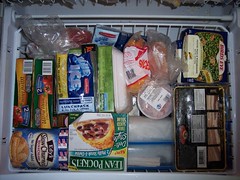 A full freezer always makes me happy - but it can also become confounding. Do you actually know what's in your freezer? Perhaps it's time to go through it all, and even take an inventory before you go shopping again. You might think you "need" to buy tuna steak, pork chops and ground beef this week, but all of those meats (and more) might be hidden way deep in the back of your freezer and you've simply forgotten that it's there. Of course, by the time you find it 6 months (or even several years) from now, it's freezer-burned, tasteless - and just more wasted money in your trash.
A full freezer always makes me happy - but it can also become confounding. Do you actually know what's in your freezer? Perhaps it's time to go through it all, and even take an inventory before you go shopping again. You might think you "need" to buy tuna steak, pork chops and ground beef this week, but all of those meats (and more) might be hidden way deep in the back of your freezer and you've simply forgotten that it's there. Of course, by the time you find it 6 months (or even several years) from now, it's freezer-burned, tasteless - and just more wasted money in your trash.

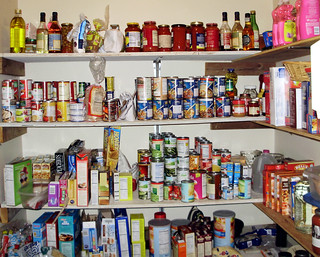 It's comforting to have a well-stocked pantry - the reassurance that, no matter what, we've got something in the house to eat, right? But be honest: how much do you cook from your pantry versus always buying fresh for your refrigerator?
It's comforting to have a well-stocked pantry - the reassurance that, no matter what, we've got something in the house to eat, right? But be honest: how much do you cook from your pantry versus always buying fresh for your refrigerator?



 Skinless boneless chicken breasts. Lamb chops. Filet Mignon.
Skinless boneless chicken breasts. Lamb chops. Filet Mignon.
 Beans are a great thing to start using more in your cooking if you want to save money and eat healthier. High in protein, fiber and very satisfying, they are great to add to soups, stews, casseroles, chilis, salads, tacos...you name it! And while canned beans typically aren't that expensive, cooking from dried beans is even cheaper. It's also extremely easy to do in a slow-cooker!
Beans are a great thing to start using more in your cooking if you want to save money and eat healthier. High in protein, fiber and very satisfying, they are great to add to soups, stews, casseroles, chilis, salads, tacos...you name it! And while canned beans typically aren't that expensive, cooking from dried beans is even cheaper. It's also extremely easy to do in a slow-cooker!

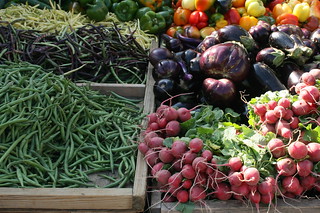 Some people claim they don't eat a lot of fruits and vegetables because they're too expensive. Well, when you're eating strawberries imported from half-way around the world, in the middle of winter, not only are they going to be expensive but they're probably not going to taste very good!
Some people claim they don't eat a lot of fruits and vegetables because they're too expensive. Well, when you're eating strawberries imported from half-way around the world, in the middle of winter, not only are they going to be expensive but they're probably not going to taste very good!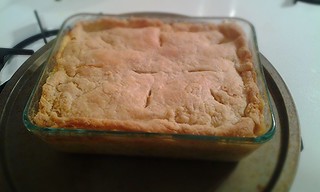 The frozen food aisles of most supermarkets promise quick and convenient meals for one, or for an entire family. But have you noticed how expensive they are for what little food you actually get? A single 9-10ounce package of Lean Cuisine could cost you anywhere from $2.50 (on sale) to $4.50 in the supermarkets near me - and is hardly a really satisfying meal.
The frozen food aisles of most supermarkets promise quick and convenient meals for one, or for an entire family. But have you noticed how expensive they are for what little food you actually get? A single 9-10ounce package of Lean Cuisine could cost you anywhere from $2.50 (on sale) to $4.50 in the supermarkets near me - and is hardly a really satisfying meal.


 Who doesn't love tortilla chips? Tasty, crunchy, and they go great with almost everything from soups to salads and dips. But a 12-14oz bag of tortilla chips can cost you easily $4.00 a pop these days - and many are loaded with salt, preservatives, artificial flavorings and fried in dubious oils.
Who doesn't love tortilla chips? Tasty, crunchy, and they go great with almost everything from soups to salads and dips. But a 12-14oz bag of tortilla chips can cost you easily $4.00 a pop these days - and many are loaded with salt, preservatives, artificial flavorings and fried in dubious oils.





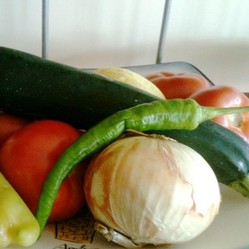

 A Potentially Fatal Accident in the Homeon 11/24/2018
A Potentially Fatal Accident in the Homeon 11/24/2018
 Windsurfing Lessons on Montserrat: One of My Funniest—and Fondest—Travel Memorieson 11/20/2018
Windsurfing Lessons on Montserrat: One of My Funniest—and Fondest—Travel Memorieson 11/20/2018
 Christmas Ornaments Celebrating Rome, Italyon 11/12/2018
Christmas Ornaments Celebrating Rome, Italyon 11/12/2018
 Philadelphia-Themed Christmas Ornamentson 11/09/2018
Philadelphia-Themed Christmas Ornamentson 11/09/2018



Comments